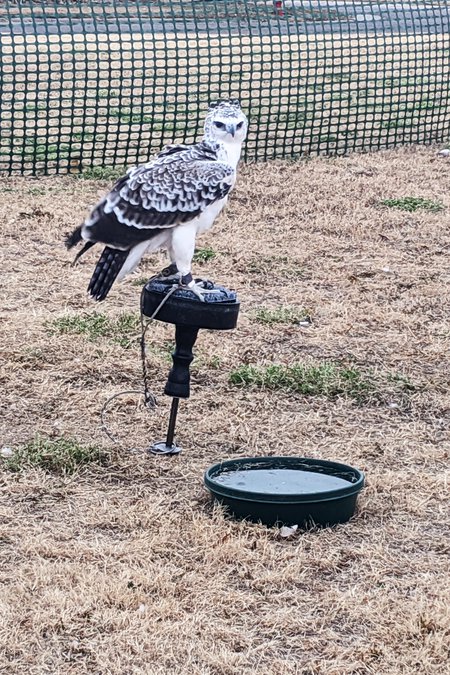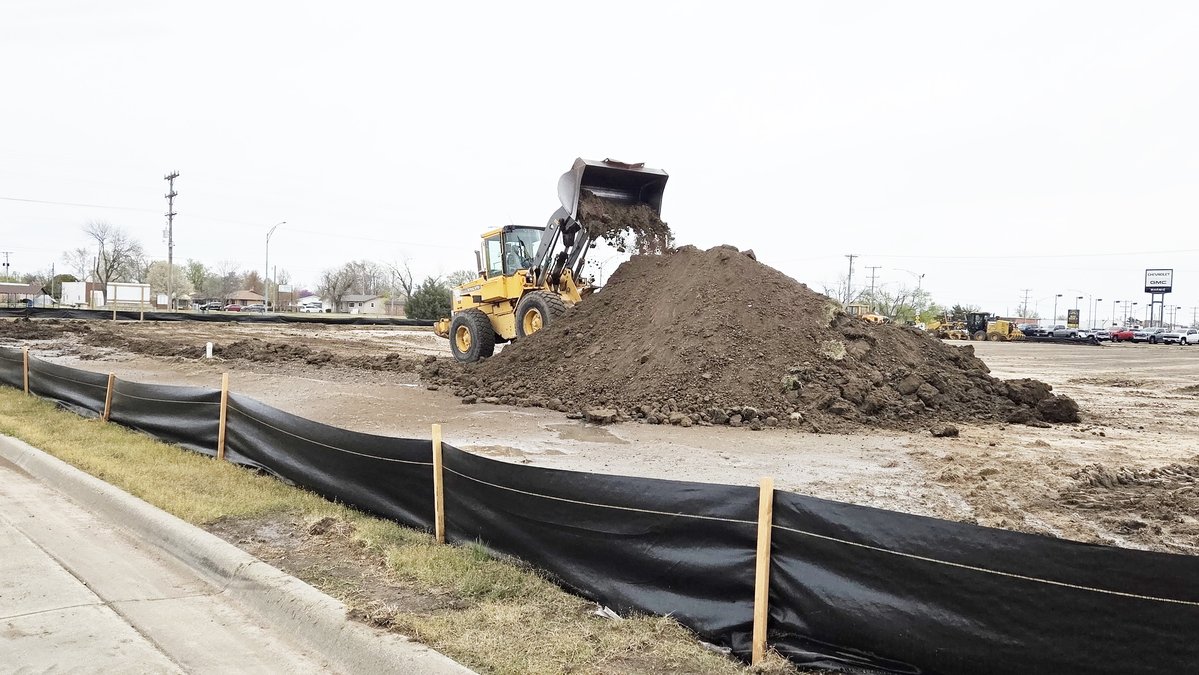Afternoons this week, activity has been up around the area of 9th Street and Monroe Street in Great Bend with a steady coming and going of people eager to get a glimpse of the numerous raptors resting in the weathering yard set up by members of the North American Falconers Association. The organization is meeting in Great Bend this year for its annual conference which has attracted a few hundred falconers from across the country and parts of Canada, Mexico, and as far away as Holland and Australia, NAFA organizer Sheldon Nicolle said.
Birds there range in size from pint-sized kestrels, North America’s smallest falcon to golden eagles, and all sizes in between. Redtail hawks, peregrine falcons, gyrfalcons, Harris’ hawks and goshawks, as well as a couple of exotic species from other parts of the world round out the roster. Each waits patiently (for the most part) to its perch, tethered within reach of water, in various stages of preparation for the day’s hunt.
The time of day falconers hunt with their birds has much to do with the size of their bird and the type of game preferred. Smaller raptors, like kestrels, for instance, will hunt smaller prey. Mice, rabbits, or starlings perhaps. Falconers need to be wary of larger birds of prey in the area that could kill their birds in the process.
“The birds are most vulnerable when they are hunting,” Nicolle said. “Sometimes bigger birds will swoop down and attack them in the air, or they will attack and kill them after they bring down prey.”
It’s just one of the things potential falconers need to be aware of as they strive to become licensed.


Growing up with the birds
Brandon Borquist and his father, Richard, are volunteer wardens of the NAFA weathering yard, keeping watch and answering questions from curious people who stop by to take photos and learn more about the ancient tradition of falconry.
“My dad started in falconry back in the mid 70s,” he said. “I grew up in it. Some of my youngest memories are going out hunting with my dad.”
Borquist started working with birds when he was 10 and became licensed as a falconer at 14. The process is rightly long and involved, considering the nature of the partnership nurtured between man and a trained wild bird. A 365 days a year commitment is required, not to be taken lightly. Getting to know the kind of quarry in your area is key to deciding what kind of raptor to start with.
“If you’ve got cottontails, then Red Tail hawks are okay, but if you’ve got more like starlings or pigeons, kestrels, little small falcons, are perfect,” he said.
After two years, a novice falconer can become a General Class Falconer, and that opens up the realm of raptors they can fly, Borquist said. Today, he can fly peregrine falcons or goshawks. It takes a minimum of seven years in order to achieve the standing of Master Class Falconer, a designation required to fly the big birds.


Master Class
Chase Delles is a Master Class Falconer. He brought three eagles with him to the NAFA convention.
“Dexter is a male golden eagle, and I’ve been flying him for 11 years, and he’s 15 years old now,” he said. He also brought two African martial eagles, both three year old males he acquired from a friend in Scotland. They are part of a captive breeding program to hopefully perpetuate the species in the United States.
Dexter was wild trapped in Wyoming in a deportation zone in 2008. Ranchers there were having issues with golden eagles killing newborn lambs, so the government declared it a deportation area and they allowed falconers to trap a certain number of golden eagles for falconer purposes.
“I have been flying birds for 20 years now,” Delles said. “I started when I was 15. I got licensed in Minnesota, but I started handling raptors when I was eight years old, with falconry in a show setting. So I’ve been doing it for a very long time.”


Licensing is challenging
cted by state, federal and international regulations, in order to become licensed, potential falconers have many hoops to jump through. A written falconry exam is necessary, and in some states hunters education is necessary, and many signatures must be acquired to complete various forms of paperwork.
Apprentice falconers are required to trap their first bird from the wild. The cost of that, plus the amount spent on food, shelter, and all other aspects of care of the bird needs to be taken into account. Plus, in order to become a licensed falconer, random inspections by game wardens must be expected. Anytime they wish to inspect where a raptor is being housed and kept, by law they must be provided access.
Sponsorship by another licensed falconer is required for the first two years, and Borquist was fortunate to have his dad fill that role. Sponsors show would-be falconers the ropes, suggest readings and ensure they have the specific basic knowledge needed to acquire and design equipment to use with their bird. The first tier of licensing allows a falconer to work with smaller raptors.
Ancient tradition
“Falconry dates back to the very beginning of recorded human history,” NAFA organizer Sheldon Nicolle said. “Kansas has got some phenomenal hunting so that’s why we like to come to Kansas.”
Today, falconry is practiced by an estimated 5,000 licensed men and women throughout the United States. NAFA membership numbers around 2,000. The field meet is their once-a-year get-together.










